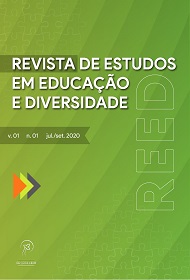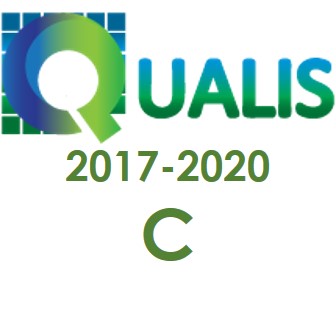SPATIAL GESTURES AND SUBJECTIVITIES FORMATION IN COLOMBIAN UNIVERSITY CAMPUS
DOI:
https://doi.org/10.22481/reed.v1i1.7450Keywords:
Spatial gestures, Formation, Stratigraphy, InhabitAbstract
This article expands from the doctoral research titled Inhabiting the formative: Spatial gestures in university cities in Colombia, attached to the Research Group on Interdisciplinary Studies on Education (ESINED) from San Buenaventura University-Medellín. This research are interested in meetings between space and formation in four university cities in Colombia, thinking about this relationship through how some of its spaces are occupy, relating with the particularities that configure them, being attentive to what is produced in these spaces; the gestures that emerge (while these spaces are occupy) in key to the formative that happens there. Starting from the stratigraphic method, some approximations were produced by the bodies and what is produced while occupy the spaces, in what is produced there and what the space tells the bodies to force them to produce gestures in a formative key.
Downloads
References
AGAMBEN, G. ¿Qué es un dispositivo? Seguido de El amigo y de La Iglesia y el Reino. Buenos Aires: Adriana Hidalgo, 2014.
ÁLVAREZ DE LA ROCHE, C. A. Una ciudad ideal en Bogotá. La ciudad universitaria de Bogotá. Revista De Arquitectura (Bogotá), v. 8, n. 1, p. 7–11, 2006.
ARANGO, J.; MARTÍNEZ, C. Arquitectura en Colombia: arquitectura colonial, 1538-1810 ; arquitectura contemporánea en cinco años, 1946-1951. Bogotá: Litografía Colombiana, 1951.
BACHELARD, G. La poética del espacio. Buenos Aires: Fondo de Cultura Económica de Argentina, 2000.
BENJAMIN, W. La obra de arte en la época de su reproductibidad técnica. México: Ítaca, 2003.
BENJAMIN, W.; TIEDEMANN, R. Libro de los pasajes. Madrid: Akal Ediciones, 2005.
BENNER, D. La pedagogía como ciencia: teoría reflexiva de la acción y reforma de la praxis. Barcelona: Pomares-Corredor, 1998.
CALVO-SOTELO, P. C. La Educación, un hecho espacial: el “Campus Didáctico” como arquitectura para el Espacio Europeo de Educación Superior. La Cuestión Universitaria, n. 5, p. 98–120, 2009.
Cronología biobibliográfica de José Pedro Varela (1845-1879). Revista Historia de la Educación Latinoamericana, v. 16, n. 22, p. 277–337, 2014.
DELEUZE, G.; GUATTARI, F. Mil mesetas. Capitalismo y esquizofrenia. Valencia: Pre-Textos, 2004.
DEWEY, J. Experiencia y educación. Madrid: Editorial Biblioteca Nueva, 2004.
ESCOBAR, A. La invención del tercer mundo: construcción y deconstrucción del desarrollo. Bogotá: Norma, 2007.
FONSECA, L.; SALDARRIAGA, A. Lenguaje y métodos en la arquitectura. Bogotá: Ediciones Proa, 1990.
FOUCAULT, M. El cuerpo utópico; Las heterotopías. Buenos Aires: Nueva Visión, 2010.
GADAMER, H. G. Verdad y método. Salamanca: Ediciones Sígueme , 1993.
GADAMER, H. G. Estética y hermenéutica. Madrid: Tecnos, 2006.
GEERTZ, C. Descripcion densa: hacia una teoría interpretativa de la cultura. En: La
interpretación de las culturas. Madrid: Gedisa, 2003. p. 19–40.
HEIDEGGER, M. Ser y tiempo. Santiago de Chile: Universidad ARCIS, 1927.
HEIDEGGER, M. Construir, habitar, pensar. [s.l: s.n.]. Disponível em: <http://bit.ly/36r5335>.
HUSSERL, E. La tierra no se mueve. Madrid: Editorial Complutense, 2006.
MADERUELO, J. La idea de espacio en la arquitectura y el arte contemporáneo, 1960-1989. Madrid: Akal, 2008.
MARTÍNEZ DE ITA, M. E.; PIÑERO, F. J.; FIGUEROA DELGADO, S. A. El papel de la universidad en el desarrollo local. Puebla: Benemérita Universidad Autónoma de Puebla, Universidad Nacional del Centro de la Provincia de Buenos Aires, 2013.
MUÑOZ, J. M. El lenguaje de los espacios: interpretación en términos de educación. Teoría de la Educación. Revista Interuniversitaria, v. 17, p. 209–226, 2005.
MUNTAÑOLA THORNGERG, J. La arquitectura como lugar. 2 ed. ed. Barcelona: Universitat Politecnica de Catalunya, 2015.
NIÑO MURCIA, C. Arquitectura y Estado. Bogotá: Universidad Nacional de Colombia, 1991.
NIÑO MURCIA, C. Arquitextos: escritos sobre arquitectura desde la Universidad Nacional de Colombia: 1976-2005. Bogotá: Universidad Nacional de Colombia, 2006.
NIÑO MURCIA, C. ¿Cómo se configura la Ciudad Universitaria? [Video]. Disponível em: <http://bit.ly/35mO95q>.
NOGUERA RAMÍREZ, C. E. Foucault profesor. Revista Educación y pedagogía, v. 21, n. 55, p. 131–150, 2009.
PARDO, J. L. Sobre los espacios pintar, escribir, pensar. Barcelona: Ediciones del Serbal, 1991.
RAMÍREZ, J. La investigación en la carrera de Arquitectura de la Universidad Nacional, 1937-1965. Una lectura de las actas de Consejo de la Facultad. Ensayos: Historia y Teoría del Arte, n. 10, p. 37–76, 2005.
RAMÍREZ POTES, F. Arquitectura y pedagogía en el desarrollo de la arquitectura moderna. Revista Educación y Pedagogía, v. 21, n. 54, p. 29–65, 2009.
RIBETTO, A. Gestos mínimos y pedagogía de las diferencias. Polis, n. 37, p. 1–11, 2014.
ROMAÑÁ, T. Arquitectura y educación: perspectivas y dimensiones. Revista Española de Pedagogia, v. 62, n. 228, p. 199–220, 2004.
SARQUIS, J. Arquitectura y modos de habitar. Buenos Aires: Nobuko Sa, 2006.
SENNETT, R. Carne y piedra: el cuerpo y la ciudad en la civilización occidental. Madrid: Alianza, 1997.
Downloads
Published
How to Cite
Issue
Section
License
You are free to:
Share - copy and redistribute the material in any medium or format; Adapt - remix, transform, and build from the material for any purpose, even commercially. This license is acceptable for Free Cultural Works. The licensor cannot revoke these freedoms as long as you follow the terms of the license.
Under the following terms:
Attribution - You must appropriately give credit, provide a link to the license, and indicate if any changes have been made. You may do so in any reasonable way, but not in a way that suggests that you or your use is endorsed by the licensor.
There are no additional restrictions - You cannot apply legal terms or technological measures that legally restrict others to make any use permitted by the license.






